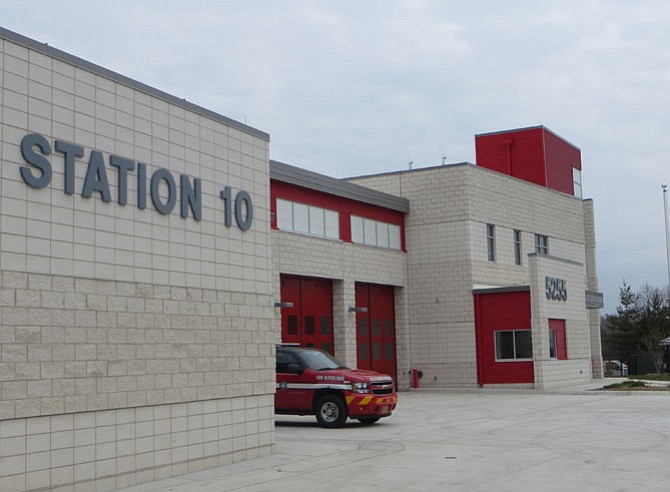Fire Station 210 near the Van Dorn Street Metro Photo by Vernon Miles.
Fire Station 210 is one of the newest and nicest buildings around the Van Dorn Metro area. It is full three-story building with four operation bays and a training tower.
Except it doesn’t have any firefighters.
Currently the facility is staffed by emergency medical technicians. Acting City Manager Mark Jinks said that, while the original plan was to have the facility be fully staffed by the end of 2015, “that process could be pushed back to the end of 2016.”
“When they first designed and built it, they were going to include a fire engine and a medic unit, but they cut the staffing funding for the engine,” said Robert Dubé, Alexandria’s fire chief. “The only thing that will be in there April 1 will be the EMS unit.”
According to Jinks, the original plan to fully staff the facility by the end of 2015 would have included a fully operational fire engine. The engine is at Fire Station 210, but according to Jinks, a higher than anticipated wave of retirements in 2014 has left the fire department understaffed and unable to both maintain current operations and supply manpower to fire station 210.
The decision to leave Fire Station 210 without firefighting capabilities has disturbed some nearby residents.
“We were told the station is complete, except there is no equipment or personnel,” said Don Buch. “We are told there is equipment, but it is being used elsewhere.”
Overall, the proposed FY 2016 budget gives a $2.2 million increase over the 2015 budget to the Alexandria Fire Department, a 4.8 percent increase from $44 million to $47 million. But 72 percent of this increase is taken up by $1.6 million in retirement costs. The fire department is also receiving $167,000 to implement career ladder opportunities for firefighters and medics. The $199,050 going to Fire Station 210 will cover operating costs.
The area’s vulnerability isn’t new. A FEMA report filed in 2004 stated that while the area has traditionally been identified as small warehouses and high-rise offices, developers have repeatedly expressed an interest in moving businesses along Eisenhower Avenue.
“Aside from the increase in growth, access to the area is limited to two roads at either end of Eisenhower Avenue,” said the report. “This results in difficulty for responding units trying to meet the five-minute response time … [and] the increase in both residential and office space will significantly increase the demand for service in the area.”
While there are six fire stations in the east end of the city and one at a central location on Duke Street, there are only two fire stations in the west end. Fire station 206 on Seminary Road and 208 at North Paxton are the two busiest fire stations in Alexandria.
The National Fire Protection Association’s 2010 report determined, based on the amount of demand, that nine minutes should be the proper response time for an urban zone and 10 minutes for a suburban zone. However, in Alexandria, the response time goal is 5.5 minutes or less. According to Google Maps, from Fire Station 206 to 210 is 10 minutes without traffic across four miles of the city and seven minutes from Fire Station 208. Dubé added that the city has a mutual aid response agreement with Fairfax, meaning if any of their fire engines are closer to the scene they will respond, but acknowledged that the response time would still be around 10 minutes. Dubé also noted that the Google maps time, without traffic, was an optimistic estimate given that fire engines still have to wait for traffic to clear a path.
According to Mark Jinks, acting city manager, “The plan has been to put an EMS unit in that station and eventually add flexibility.”
There’s not a clear answer at the moment whether the station is open or not. While the facility is currently staffed with EMS personnel, Jinks said the facility hasn’t yet had any kind of grand opening. Currently, that ribbon cutting is planned for April 6.
Jinks and Dubé both noted that the city’s primary concern regarding fire hazards around 210 is the Norfolk Southern rail line. According to Jinks, any kind of chemical or hazardous spill or fire that would occur in Alexandria would likely be connected to the railway immediately adjacent to Fire Station 210. To combat any sort of chemical emergency, the firefighting crew would need to utilize a special 20-foot utility trailer, which carries absorbent materials, containers, and various tools to combat hazardous material incidents. However, the trailer is currently housed with the rest of Alexandria’s Hazardous Materials Response Team at Fire Station 209 in Potomac Yard. The drive from Alexandria Fire Station 209 to Fire Station 210 is approximately 11 minutes without any traffic on the roads.
“West end residents are concerned about an ethanol unit,” said Dubé. “That certainly is a concern, but we also have a mutual aid response from Fairfax. It’s not that it’s not going to get a response.”
At the March 23 City Council meeting, the Eisenhower West Development Plan was presented by Karl Moritz, Alexandria director of Planning and Zoning. In each of the proposed scenarios, the city plans on expanding both industrial and residential uses in the area around Fire Station 210.
“We’re looking at Eisenhower Avenue West as a great street,” said Councilwoman Del Pepper. “Not as we see it, but its full potential of what it could be. It takes a little adjusting of the brain cells to imagine its full potential. We need to be seeing this as something greater than it is right now.”
But Pepper acknowledged that the city’s plans for the future of Eisenhower West seem directly at odds with the empty Fire Station 210.
“This is like opening a library without any books in it,” said Pepper. “We do not want this to be a symbol that West End services don’t matter.”

